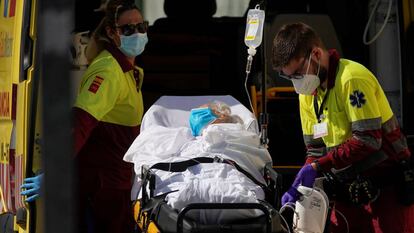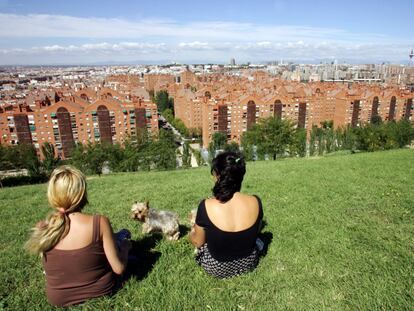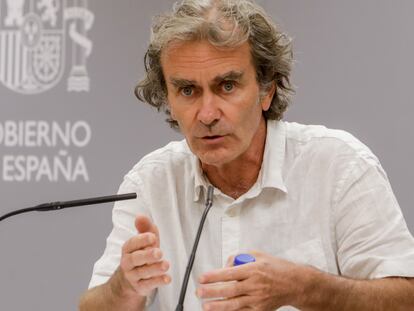Madrid accounts for a third of new coronavirus cases detected in the last week
The Spanish Health Ministry on Tuesday reported 50,000 positives nationwide over seven days, with 8,155 added in just the last 24 hours

Madrid is a cause for concern. That was the opinion voiced on Monday by Fernando Simón, the director of the Spanish Health Ministry’s Coordination Center for Health Alerts (CCAES), and repeated on Tuesday by the prime minister, Pedro Sánchez, during an interview with the Cadena SER radio network. With 14% of the population of Spain, in the last week the region has accumulated nearly a third of all of the new coronavirus cases detected: 14,871 of a nationwide total of 49,399 – 8,155 of which were reported on Tuesday from the previous 24 hours. Something similar is taking place in terms of hospitalizations: 30% of Covid-19 patients in the country, 6,807, are in Madrid, according to the latest data released on Tuesday by the Health Ministry.
Madrid’s share of the total number of cases shot back up in August, after the month of July saw the virus spreading fast through the Aragón and Catalonia regions. At that point, Madrid only accounted for 12% of the total number of positives, a figure that is more in line with the proportion of its population. But according to consolidated data from the Carlos III Health Institute, up to August 23, the figure is now at 28%, in line with what was seen from the outset of the health crisis in March.
Regional powers
In Spain, both education and healthcare are controlled by the country’s 17 regional governments. During the state of alarm and coronavirus lockdown, implemented in mid-March, the Socialist Party (PSOE)-led government of Prime Minister Pedro Sánchez centralized regional powers in a bid to curb the spread of the virus. Many regional leaders – including Madrid premier Isabel Díaz Ayuso of the conservative Popular Party (PP) – voiced calls during this time for an end to the state of alarm and the return of full powers to the regions. This was granted in June, when the emergency situation came to an end. But as the country enters a second wave of the virus, there have been demands – including from Ayuso – for the government to take control once more, in particular in areas such as the reopening of schools. For now, however, Sánchez is leaving the overall control of the handling of the crisis in the hands of the regional governments.
“Madrid is the region where we need to focus all of our attention,” explains Álex Arenas, a physicist and researcher at the Rovira i Virgili University in Tarragona, and an expert in mathematical models.
His calculations predicted with reasonable accuracy how the epidemic would behave in the first wave and he is fine tuning them to anticipate what will happen in this second one. But, he warns, everything depends on the measures that are taken and how much mobility increases with the return to the workplace in September and the start of the new school year. He warns that if the current trends continue, the situation will “be very difficult once more” in a very short space of time.
“If we manage to get 30% of the population working from home, that will be a significant reduction in mobility, which could help,” he explains. But that won’t be sufficient for Madrid. “There needs to be some kind of confinement in the south so that the virus does not have an impact in the rest of the healthcare areas, before spreading to the adjacent areas and then the rest of the country.”
Many epidemiologists were shocked to see Madrid move to the “new normality” with a completely insufficient number of contact tracers
Part of the problem in Madrid is precisely the fact that it is a hub, a dense city with the biggest metropolitan area in Spain, with huge numbers of journeys taken on public transportation, and a lot of the characteristics that are needed for the spread of the SARS-CoV-2 virus. Simón interpreted the rising figures in August as a result of the return of many holidaymakers to the city after their summer vacation, as he explained on Monday, adding that the same problem could occur in September.
But there are more factors to consider. Many epidemiologists and public-health experts were shocked to see Madrid move to what the government has dubbed the “new normality” with a completely insufficient number of contact tracers in terms of the size of its population. During the months of June and July there was a trickle of cases without links – there was not the capacity to locate their contacts.
According to a report from the CCOO labor union released on Tuesday, the regional government has hired just 210 of these professionals since June. That was the figure supplied by the general director of the regional public health service, Elena Andradas. At the end of May, the regional government itself reported to the Health Ministry that it had 169 contact tracers. That’s to say, there are fewer than 400 contact tracers working in the region right now, when the international standard suggests that Madrid should have more than 1,200 based on its population.
Madrid’s deputy premier on Tuesday criticized what he called the government’s “self-serving obsession” with the region
During his interview on Cadena SER on Tuesday, Sánchez avoided pointing the finger nor highlighting regions that have failed to shore up their public health systems, but he did hint that Madrid was one of these. “You only have to look at the figures,” he said. The regional premier, Isabel Díaz Ayuso of the Popular Party (PP), didn’t hesitate to respond. On Monday, after hearing Simón’s comments about the situation in the region, she accused the Health Ministry of “unfair, disproportionate cruelty, which is damaging for Spain.” The deputy premier, Ignacio Aguado of Ciudadanos, on Tuesday criticized what he called the government’s “self-serving obsession” with the region.
The experts insist, however, that while the data may resemble those of March, the situation is completely different. The high number of tests being carried out now means that the progress of the situation can be anticipated. That said, there are more and more voices warning that if the measures currently in place do not work, or more drastic ones are not implemented, the situation in Madrid’s hospitals could once again be a problem. “There are scant hopes that the spread [of the virus] is going to slow down in the coming weeks,” warns Pedro Gullón, from the Spanish Epidemiological Society. “Primary healthcare is already overwhelmed and there is already a rise in the pressure on hospitals, although it is very uneven in terms of which ones. The 12 de Octubre, for example, is much more overcrowded than others.” The occupation of Covid-19 patients in Madrid is currently 15% of total capacity, compared to the average of 6% in all of Spain.
The return to the workplace and to schools in September threatens new spikes that could serve to accelerate the spread of the virus. “With this pandemic, we’ve had a problem of timing,” explains Arenas. “You can do everything right, but if you’re too late, you don’t have the necessary effect. We’ve arrived late with contact tracing, PCR testing, and now we are doing badly with the reopening of schools, and by not waiting until infection rates fall it’s very likely that they will have to close again in a matter of weeks.” In his opinion, schools should remain closed when the cumulative incidence of cases over the previous two weeks is above 50 cases per 100,000 inhabitants. Only Asturias meets that criteria right now, with Madrid at 479 cases per 100,000 inhabitants, followed by the Basque Country (354), La Rioja (353) and Aragón (319). The remainder of Spain’s regions are under 300.
With reporting by Daniele Grasso.
English version by Simon Hunter.
Tu suscripción se está usando en otro dispositivo
¿Quieres añadir otro usuario a tu suscripción?
Si continúas leyendo en este dispositivo, no se podrá leer en el otro.
FlechaTu suscripción se está usando en otro dispositivo y solo puedes acceder a EL PAÍS desde un dispositivo a la vez.
Si quieres compartir tu cuenta, cambia tu suscripción a la modalidad Premium, así podrás añadir otro usuario. Cada uno accederá con su propia cuenta de email, lo que os permitirá personalizar vuestra experiencia en EL PAÍS.
¿Tienes una suscripción de empresa? Accede aquí para contratar más cuentas.
En el caso de no saber quién está usando tu cuenta, te recomendamos cambiar tu contraseña aquí.
Si decides continuar compartiendo tu cuenta, este mensaje se mostrará en tu dispositivo y en el de la otra persona que está usando tu cuenta de forma indefinida, afectando a tu experiencia de lectura. Puedes consultar aquí los términos y condiciones de la suscripción digital.
More information
Últimas noticias
All the effects of gentrification in one corner of Mexico’s Colonia Roma
Palestinian reporter Youmna El Sayed: ‘My family told me I had to choose between being a journalist or a mother’
Russell Tovey: ‘I was advised many times not to come out, I don’t think there was many people who’d done that — and I feel really proud that I’m one of those that did’
Merz tries to replace Macron at the helm of Europe
Most viewed
- Families demand repatriation of bodies of Colombians who died in Ukraine: ‘This war is a slaughterhouse for foreigners’
- The low-cost creative revolution: How technology is making art accessible to everyone
- Liset Menéndez de la Prida, neuroscientist: ‘It’s not normal to constantly seek pleasure; it’s important to be bored, to be calm’
- Christian Louboutin: ‘Young people don’t want to be like their parents. And if their parents wear sneakers, they’re going to look for something else’
- US sanctions against jailed cartel leader ‘El Marro’ highlight Mexico’s lack of control over its prisons











































